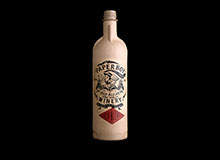

The innovative creation, aptly titled Paperboy, is the brainchild of packaging and design branding company Stranger and Stranger who devised the bottle in conjunction with US wine corporation Truett Hurst Inc and UK-based paper bottle manufacturer Green Bottle.

Discover B2B Marketing That Performs
Combine business intelligence and editorial excellence to reach engaged professionals across 36 leading media platforms.
Paperboy boasts many eco-friendly benefits and is the first of its kind in the wine sector. Weighing in at only 0.86kg when full, the paper bottle is 85% lighter than its glass counterpart. In addition to collapsing when it is empty, making it to recycle, the energy needed to make Paperboy is just 15% of the energy needed to make a glass bottle. For wine connoisseurs both in the UK and US, Paperboy provides a portable, refined and classic beverage package, whilst simultaneously reducing our carbon footprint.
Sonia Sharma: How did the idea for the concept of Paperboy come about?
Kevin Shaw: Stranger got approached by a partner in a paper forming company who were trying to make a paper bottle but couldn’t quite crack the product. We did some bottle designs and created a brand that would bring the whole idea together and got together with Phil Hurst of Truett Hurst who invested the wine and bottling line development to bring it to market.
SS: What is the main motivation behind making Paperboy?
KS: We wanted to create a brand that would appeal to those concerned about conservation and the environment but also make use of the intrinsic values of this product to make wine fun and accessible to a younger outdoor lifestyle.
SS: How long did it take to develop and how long has it been around?
KS: It took about a year to get everything together and we launched it four months ago in Safeway.

US Tariffs are shifting - will you react or anticipate?
Don’t let policy changes catch you off guard. Stay proactive with real-time data and expert analysis.
By GlobalDataSS: Why should the drinks industry make the change to paper wine packaging?
KS: The wine industry is one of the most energy hungry and wasteful sectors in the whole of retail. To produce a paper bottle takes only 15% of the energy that it takes to produce a glass bottle and only takes a fraction of the energy to recycle. When empty the paper bottle only weighs an ounce which means you can pick up a case of wine with one hand. Then there’s the shipping: the industry is dominated by heavy glass bottles which are shipped around the globe twice – once empty to wineries and then again full to retailers.
Do you know how much energy is spent just shipping almost 40 billion empty bottles to wineries to be filled each year? No, neither do I but it must be a lot. Plus, trucks are filled by weight and, when shipping wine, often travel just over half full. Paper bottles can be shipped stacked like egg cartons – no waste space – and are light so the trucks can be filled to capacity. The energy savings are colossal.
SS: Are consumers ready to make the change from traditional glass bottles to paper? Do you think consumers are becoming more aware of their own ‘eco-choices’?
KS: In Britain, a few years ago, you could only get bottles with corks in them. Then one supermarket, after realising that 98% of wine was drunk within 7 hours of purchase, championed screw tops as keeping wine fresher and more consistent. The idea was taken up by early adopters, took off, and today it’s tough to find a cork in Britain.
Paperboy will always appeal to people who are concerned about the environment and people who don’t want to take glass bottles by the pool, on boats or to festivals but we hope that paper bottles gain wider appeal. Right now we certainly can’t make enough of them.
SS: How has Paperboy been received by the industry so far?
KS: So far it’s been seen as revolutionary but every single retailer we showed it too has been really excited about it because there’s been very little innovation in the wine trade for 300 years. I’m sure the wine snobs are looking down their noses at it but the winemaker, Ginny Lambrix, just got a handful of 90 point scores from Robert Parker this year so the wine delivers.
SS: How have Stranger and Stranger designed Paperboy to ensure it stands out on the shelf?
KS: It’s the only paper wine bottle in the world so it stands out anyway, but we’ve used strong cool retro graphics to kick against all the thousands of dull brands. The average consumer spends less than 30 seconds in the wine aisle so you have to stand out.
SS: How long does a Paperboy wine bottle last?
KS: It’s bag in box technology so it should be good for a year or two.
SS: How green and sustainable is the design?
KS: The outer is made from undyed recycled paper waste and printed with natural inks so can even be pulped into your compost, the top is standard aluminium so can be completely recycled and the bladder liner is the only non-recyclable part but we’re working on that.
SS: Where do the materials to make the bottle come from?
KS: Paperboy is made from compressed paper waste recycled from the cardboard industry; it contains a bladder of wine as you might find in bag in box wines and a standard screw top.
SS: How is the packaging able to chill wine for longer?
KS: Paper and card are simply superb insulators.
Follow Sonia Sharma on Google+





